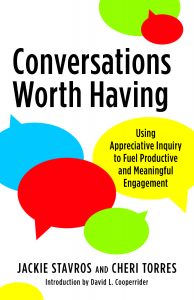Preview Thursday: Conversations Worth Having

Best of Books
October 25, 2018
WI Admin
Topics
Appreciative Inquiry, Cheri Torres, Conversations Worth Having, Jackie Stavros, Preview Thursday, problem solverWe are pleased to present this excerpt from Conversations Worth Having by Cheri Torres & Jackie Stavros.
Any Time, Any Place, Any Situation
 Appreciative Inquiry (AI) is a strengths-based approach used to discover the best in people, organizations, and the communities around them. AI research has shown that systems (of self, teams, organizations, and communities) move in the direction of the questions people ask. AI initiates positive emotions and opens the doorway to unimagined possibilities for those who experience this way of being in and making sense of the world. This way of being is perhaps best described by Jane Magruder Watkins, a senior AI practitioner, OD consultant, and author, who says AI is “a habit of mind, heart, and imagination that searches for the success, the life-giving force rather than disaster and despair.”1 Starting appreciative and inquiry-based conversations is basically a matter of learning two simple practices: applying positive framing and using generative questions. When following the AI principles becomes second nature, you yourself will naturally initiate productive and meaningful interactions most of the time.
Appreciative Inquiry (AI) is a strengths-based approach used to discover the best in people, organizations, and the communities around them. AI research has shown that systems (of self, teams, organizations, and communities) move in the direction of the questions people ask. AI initiates positive emotions and opens the doorway to unimagined possibilities for those who experience this way of being in and making sense of the world. This way of being is perhaps best described by Jane Magruder Watkins, a senior AI practitioner, OD consultant, and author, who says AI is “a habit of mind, heart, and imagination that searches for the success, the life-giving force rather than disaster and despair.”1 Starting appreciative and inquiry-based conversations is basically a matter of learning two simple practices: applying positive framing and using generative questions. When following the AI principles becomes second nature, you yourself will naturally initiate productive and meaningful interactions most of the time.
Getting Started with the Basic Practices
One place to begin is to observe conversations at home and at work. Try this exercise for a day before you start intentionally practicing positive framing and generative questions (though it might be hard to stop yourself if you’ve read this far!):
1. Get an index card and label one side “positive” and the reverse side “negative.” After each conversation you observe or have (regardless of how long or short, and whether you are observing others or having a conversation with yourself or someone else), put a tick mark on the side representing whether it was an appreciative (positive) or a depreciative (negative) conversation. If it was a conversation you participated in, jot down a couple of words to remind yourself of how you felt during and after the interaction and whether it was worthwhile overall. If it was a conversation you observed, write down a few notes about where you were and what the tone and the direction of the interaction were. Note your observation of people’s body language.
2. At the end of the day, reflect on your conversations and also those you observed. You might also reflect on how you feel about the day and what you’ve accomplished.
3. You can calculate your positivity ratio by adding up the total positive vs. negative conversations you had. If your ratio is less than 3:1, it’s time to change your conversations. Fortunately, there’s a simple way to do that!
If you’re an effective problem-solver, you’ve probably been rewarded for that quality throughout your life. We are not suggesting that you give up this very effective skill. Rather, we ask you to be aware of when an appreciative approach might be more effective. We invite you to experience the difference between finding a solution using a more traditional problem-solving approach and using an appreciative approach. To confirm the power of this comparison, try the following exercise several times today or tomorrow:
1. When you are with people, consciously identify problems. Come up with solutions or ask problem-solving questions. Observe others’ reactions and responses. Problem- solving questions typically entail asking about what’s wrong, what’s not working, and why. Notice the dynamics of these conversations. Observe subtle body language, as well as the tone and direction of the conversation. Along these same lines, if someone presents you with a problem, begin brainstorming solutions and notice how the conversation flows.
2. Then, consciously change to positive framing and ask generative questions. Positive framing flips the problem to a desired outcome. Generative questions seek to uncover what’s working, what’s going well, what’s of value in a situation, what might be of value, what’s possible, and what’s desired. If someone else suggests the problem, ask them a generative question to flip the focus—for example, “This project is never going to work with the way it’s designed.” A generative question might instead be “What changes could we make so it would work?” Again, notice what happens to the dynamics of the conversation. Pay attention to changes in body language, the energy level, and the tone and direction of the conversation. This can be especially powerful when someone presents you with a problem they are trying to solve. It might be helpful to first find out what they really want.
3. What emotions and feelings do these different ways of engaging in conversations generate—for you and for others? If you’re a great problem-solver, such conversations might be energizing for you. What about others in the conversation? Which of these approaches builds stronger relationships among everyone? Makes room for everyone? Inspires the most innovative solutions?








